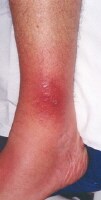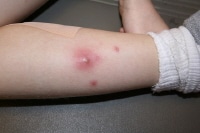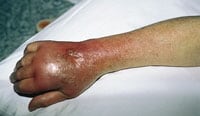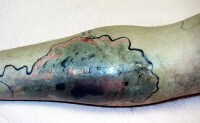ngeee... i'm on the way to my final year.. n yes. i've got my thesis topic, which is the effect of limeberry extraction as an anti-cellulitis agent. sedikit excited di sini coz my supervisor is superly adorable by students! yeay~ hopefully, my final year is gonna be a most memorable year.. below are the link for definition of cellulitis and more..
(copy from a web..)
Etiology
Host factors
Certain host factors predispose to severe infection. Individuals with comorbid conditions such as diabetes mellitus (frequently polymicrobial), immunodeficiency, cancer, venous stasis, chronic liver disease, peripheral arterial disease, chronic kidney disease, and other systemic disease appear to be at a higher risk for both recurrent and more severe infection, owing to an altered host immune response. Other factors that affect host immunity and predispose to cellulitis include concurrent intravenous (IV) or subcutaneous (SC) “skin popping” drug use; infections in this setting are most often polymicrobial, but community-associated methicillin-resistant S aureus (CA-MRSA) is also a common pathogen.
In individuals with normal host defenses, the most common causative organisms are group A streptococci (GAS) and S aureus. Group BStreptococcus cellulitis occurs in infants younger than 6 months, as their immune responses are not fully developed. The cellulitis may present as sepsis[6] ; underlying osteomyelitis or septic arthritis must be excluded in these infants. (See the image below.)
 A case of cellulitis without associated purulence in an infant. Note the presence of lymphedema, a risk factor for cellulitis (Photo courtesy of Amy Williams).
A case of cellulitis without associated purulence in an infant. Note the presence of lymphedema, a risk factor for cellulitis (Photo courtesy of Amy Williams).In children, facial cellulitis is frequently associated with H influenzae type B and S pneumoniae; prophylactic pneumococcal vaccine may be effective in the latter cases. A study of one-half million pediatric hospitalizations demonstrated that, although bacterial meningitis and epiglottitis diminished as a result of immunization for H influenzae type B and S pneumoniae, the incidence of facial cellulitis was unaffected.[7] However, another study noted that 96% of the serotypes that cause facial cellulitis are included in the heptavalent-conjugated pneumococcal vaccine that is licensed in the United States.
Immunocompromised hosts typically become infected from opportunistic organisms, including gram-negative rods (eg, Pseudomonas, Proteus, Serratia, Enterobacter, Citrobacter), anaerobes, and others (eg, Helicobacter cinaedi, Fusarium species). Although fungi (eg, Cryptococcus) may also cause cellulitis, this is rare.
Pneumococci may cause a particularly malignant form of cellulitis that is frequently associated with tissue necrosis, suppuration, and bloodstream invasion. Two distinct syndromes are recognized: the first is marked by involvement of the extremities in patients with diabetes or substance abuse, and the second is marked by involvement of the head, neck, and upper torso in patients with systemic lupus erythematosus, nephrotic syndrome, or hematologic disorders.[8]
Mycobacterial infections may present as cellulitis. Typically, the lack of response to antibiotics prompts further investigation. The diagnosis is made based on the presence of granulomas, multinucleated giant cells, and acid-fast bacilli (AFB) from biopsy specimens.[9, 10, 11]
S aureus is the leading cause of soft-tissue infections in injection drug users,[12] followed by Streptococcus species.[13]
Gram-negative bacteria may cause bullous cellulitis in patients with cirrhosis.[14] Early recognition is vital, as the course of the disease is rapid, typically progressing to septic shock and death. Gram stain and culture of fluid aspirated from the bullae may aid in management.
Recurrent staphylococcal cellulitis may occur in patients with nasal carriage of staphylococci and those with Job syndrome.
Hospital-acquired infections
Various hospital-acquired infections following soft-tissue trauma may lead to cellulitis, such as those around surgical wounds less than 24 hours postoperatively (group A beta-hemolytic Streptococcus [GABHS] orClostridium perfringens, which produces gas that may be appreciated as crepitus on examination) or from gunshot wounds or invasive devices (Acinetobacter baumannii is an emerging multidrug-resistant pathogen in these scenarios.)[15]
Cellulitis due to lymphatic obstruction or venectomy is generally caused by non–group A streptococci (ie, groups B, C, and G).[16, 17] Postvenectomy status following saphenous vein stripping can also result in cellulitis[16] and is associated with tinea pedis; culture of toe web spaces may assist in identifying a bacterial pathogen.[18] Lymphadenectomy following tumor excision, such as mastectomy, is also a predisposing factor for cellulitis.
Varicella
Cellulitis can complicate varicella and may be identified by a margin of erythema surrounding the vesicles. In one study, patients with invasive GAS cellulitis complicating varicella were identified.[19] The median onset of GAS infection was day 4 of varicella, with fever, vomiting, and localized swelling reported.[19] This condition mandates antibiotic treatment and careful clinical follow-up. Untreated cellulitis in association with varicella may progress to severe necrotizing soft-tissue infections requiring surgical intervention.[20]
MRSA
Cellulitis can be complicated by abscess formation. A maxim in microbiology states, "The hallmark of staph infection is abscess formation." This has become a significant concern due to changing patterns of antibiotic resistance in S aureus, particularly MRSA.[21]
MRSA was first reported in 1968[22] ; for years, MRSA infections were identified only in patients with recent hospitalization, surgery, renal dialysis, residence in long-term-care facilities, or IV drug use. However, in recent years, isolates of S aureus have been found in patients without risk factors for nosocomial disease.[23] These isolates have been termed CA-MRSA to distinguish them from the previously identified hospital or healthcare-associated MRSA (HA-MRSA). (See the images below.)
Although reports have indicated that MRSA causes the majority of skin and soft-tissue infections (SSTIs), these studies are plagued by variability in case-finding methodologies.[24] Furthermore, in the context of cellulitis, the finding is misleading in that these reports come from analysis of wound cultures in cases in which abscess formation occurred. Cultures in cellulitis are difficult to perform and are infrequently done. Therefore, the results of these studies cannot be generalized to cellulitis without abscess formation. Studies are under way to determine the incidence of S aureus —in particular, CA-MRSA in soft-tissue infection in which there is no identifiable abscess. However, until results of those studies are available, treatment decisions must be made on clinical grounds.
 Patient with cellulitis of the left ankle. Note the area of drainage. This cellulitis was caused by community-acquired methicillin-resistant Staphylococcus aureus (CA-MRSA). (Photo courtesy of Texas Dept. of Public Health)
Patient with cellulitis of the left ankle. Note the area of drainage. This cellulitis was caused by community-acquired methicillin-resistant Staphylococcus aureus (CA-MRSA). (Photo courtesy of Texas Dept. of Public Health) Abscess and associated cellulitis caused by community-acquired methicillin-resistant Staphylococcus aureus (CA-MRSA). (Photo courtesy of Texas Dept. of Public Health)
Abscess and associated cellulitis caused by community-acquired methicillin-resistant Staphylococcus aureus (CA-MRSA). (Photo courtesy of Texas Dept. of Public Health) Hand cellulitis caused by community-acquired methicillin-resistant Staphylococcus aureus (CA-MRSA).
Hand cellulitis caused by community-acquired methicillin-resistant Staphylococcus aureus (CA-MRSA).Bite wounds, lacerations, and puncture wounds
Mammalian bite wounds represent a specific subset of cellulitis with unique pathogens. The infections are usually polymicrobial.[25] Human, dog, cat, and wild-animal bites all predispose to cellulitis with unique pathogens, but dogs are the most commonly encountered bite wound in both the primary care and emergency setting.[26] Several organisms are of particular interest in animal bites, including the following[25] :
- Capnocytophaga canimorsus (dog)
- Eikenella corrodens (human)
- Pasteurella multocida (dog or cat)
- Streptobacillus moniliformis (rat)
Puncture wounds, especially through the bottom of athletic shoes, may cause Pseudomonas osteomyelitis and/or cellulitis. However, lacerations and puncture wounds sustained in an aquatic environment (eg, oceans, lakes, streams) may be contaminated with bacteria not typically found in land-based injuries, including Aeromonas hydrophila, Pseudomonas and Plesiomonasspecies, Vibrio species, Erysipelothrix rhusiopathiae, Mycobacterium marinum, and others.[27] Individuals with chronic liver disease are particularly susceptible to V vulnificus infections (see the image below).[28]
 Cellulitis due to documented Vibrio vulnificus infection. Image courtesy of Kepler Davis.
Cellulitis due to documented Vibrio vulnificus infection. Image courtesy of Kepler Davis.phewww.. mcm susah je.. err..

No comments:
Post a Comment